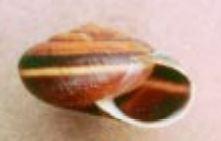Low-
Moderate
The population size of the Dalles sideband is low and the trend is unknown. These terrestrial snails are very rare and have distributions that include small, isolated populations, perhaps remnants of previously much wider ranges. These small, isolated populations, often associated with old-growth and/or riparian hardwoods and are very vulnerable to logging, road building, fires, or other disturbances.
Description and Range
Physical description
Taxonomic note: Dalles sideband is in the family Bradybaenidae.
Ecology and life history
The Dalles sideband has been found in moist talus habitat (especially around seeps and springs), and in forested areas in upland sites near, but outside of, riparian corridors. In some forested sites, the species has been found associated with down wood where no rock substrates occur. Down wood may provide temporary refugia used during dispersal in the wet season, while rock substrates provide more stable refugia used for estivation during summer and winter and during fire events.
Land snails are hermaphroditic and exchange gametes with other conspecific individuals when conditions are favorable, typically in the spring, and then both will lay eggs in damp subsurface situations where the eggs will be relatively safe from predators and desiccation. Land snails do not tend their eggs or young. There is no larval stage and newborn snails look like miniature adults (the innermost part of the shell develops within the egg).
Snails need moisture, so where the habitat dries out, they will estivate in the summer, become active with fall rains, and hibernate when the season turns cold.
Land snails eat plants (living or dead), fungi, fruit, microorganisms, litter, wood, and dead animals.
Loose soil may be necessary for egg-laying by sideband snails, which lay several dozen eggs; they are likely to live more than six years, and probably mature in two years. During the moist spring and fall seasons, Dalles sidebands may be found in the open, away from refugia. Daily refugia used during moist seasons can be down wood, rock or accumulations of litter.
During the summer, snails are found deep in talus accumulations which are adjacent to springs or streams and which serve as refuge sites from desiccation and protection from predators while the snails are immobile. These deep rock refugia also provide the important, environmentally stable sites needed to survive wildfire events and cold winter conditions.
Mollusks which inhabit talus habitats also utilize the surrounding forest areas during moist, cool conditions, ranging out from the refugia provided by the rocks to forage in the adjacent forest floor litter.
Geographic range
This species is known from the Columbia Gorge from Hood River east to the vicinity of The Dalles on both sides of the Columbia River and in upland sites in the lower Deschutes River watershed within Mt. Hood National Forest in Wasco County, Oregon.
The species may have occurred historically in the central and part of the eastern Columbia Gorge and south up the Deschutes River Valley as far as 50 miles from the confluence.
A total of 98 sites are known, but most sites are in Oregon, and only a few individuals have been found at most sites. Known sites are widely scattered across the species’ range and separated by non-habitat.
The distribution of stable rock refugia sites across the landscape may determine or help to explain the distribution of the species in areas with short fire-return intervals.
For a map of range-wide distribution and conservation status of this species, check out NatureServe Explorer.
Climate vulnerability
Sensitivity to climate change
Low
There is limited information on the sensitivity of this species to climate change. This snail is frequently found in cool, moist talus habitat and upland forest areas that are near riparian corridors. Activities or events that alter conditions, such as moisture levels, shade, and temperature, may make this species vulnerable.
Exposure to climate change
Moderate
- Increased temperatures
- Reduced soil moisture and/or drought
- Altered fire regimes
Conservation
Conservation Threats and Actions Needed
- Fish and wildlife habitat loss or degradation
- Threat: Road building; habitat alteration that creates xeric (dry) conditions.
- Action Needed: Develop management recommendations.
See the Climate vulnerability section for information about the threats posed by climate change to this species.
Resources
References
Applegarth, J. S. 2000. Management recommendations for terrestrial mollusk species Megomphix hemphilli the Oregon Megomphix. Version 2.0. Unpublished report to the Oregon Bureau of Land Management. 39 pp.
Burke, T. E. 2013. Land Snails and Slugs of the Pacific Northwest. Oregon State University Press, Corvallis, OR. 344 pp.
Duncan, N. 2005. Conservation Assessment for Monadenia fidelis minor, Dalles Sideband. Originally issued as Management Recommendations by T. R. Weasma, 1998. Revised by N. Duncan. USDA Forest Service Region 6 and USDI Bureau of Land Management, Oregon and Washington, 14pp.
Frest, T. J. 1999. A Review of the land and freshwater Mollusks of Idaho. Final report to the Idaho Conservation Data Center, Idaho Department of Fish and Game, 600 South Walnut, P.O. Box 25, Boise, Idaho 83707. 281 pp. plus appendices.
Hendricks, P., B. A. Maxell and S. Lenard. 2006. Land Mollusk Surveys on USFS Northern Region Lands. A report to the USDA Forest Service, Northern Region. Montana Natural Heritage Program, Helena, Montana. 11 pp. plus appendices.
NatureServe. 2014. NatureServe Explorer: An online encyclopedia of life [web application]. Version 7.1. NatureServe, Arlington, Virginia. Available http://explorer.natureserve.org. (Accessed September 11, 2014 ).
Pilsbry, H. A. 1948. Land Mollusca of North America (north of Mexico). Monograph of the Academy of Natural Sciences of Philadelphia, 2(2): 521-1113.
Stone, T., 2009. Crowned Tightcoil (Pristiloma pilsbryi). Species Fact Sheet. Interagency Special Status/Sensitive Species Program, Forest Service, Bureau of Land Management. 5pp.
USFWS. 2011. Endangered and Threatened Wildlife and Plants: 90-day finding on a petition to list 29 mollusk species as threatened or endangered with critical habitat: proposed rule. Federal Register 76 (No. 193, October 5, 2011): 61826-61853.
